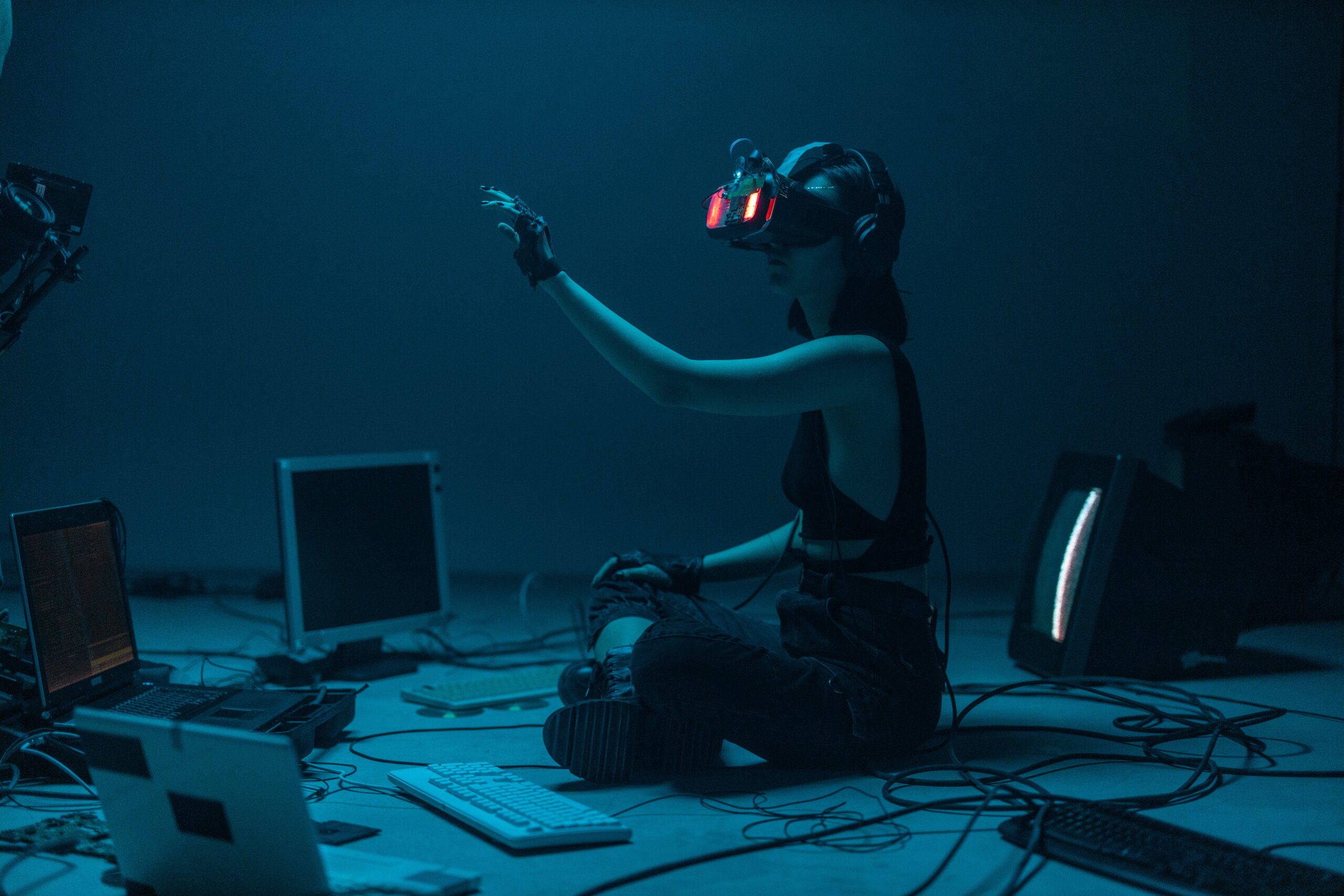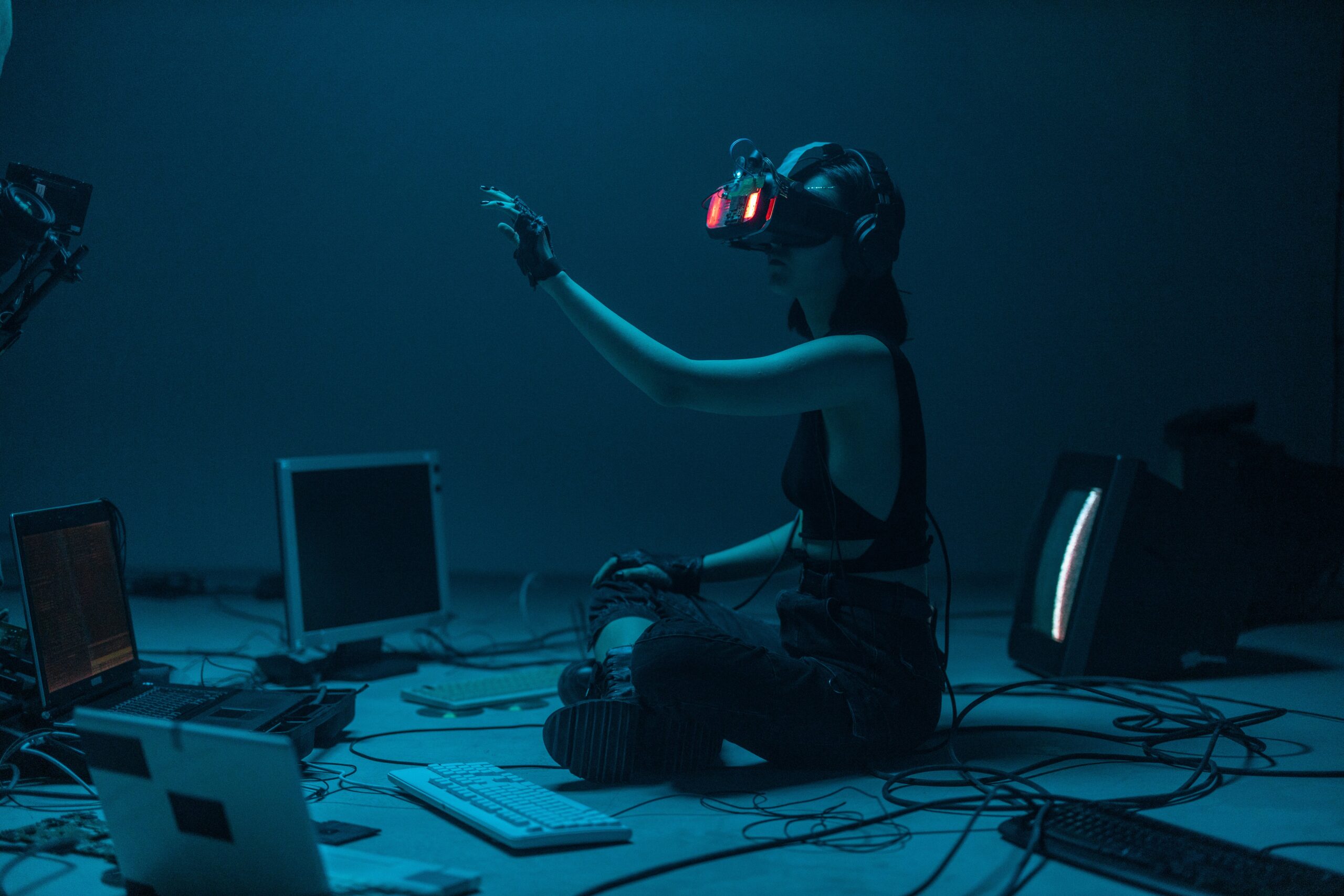In the ever-evolving world of digital technology, Augmented Reality (AR) has emerged as a game-changer in the field of digital transformation. By blending the virtual and physical worlds, AR has paved the way for innovative and immersive experiences across various industries. Whether it is enhancing customer engagement, streamlining business operations, or revolutionizing marketing strategies, AR holds the key to unlocking online success. This article delves into the transformative power of Augmented Reality in digital transformation, shedding light on how businesses can harness its potential to optimize their websites, stay ahead of the competition, and embrace the future of technology.

Understanding Augmented Reality
Definition of Augmented Reality
Augmented Reality (AR) is a technology that combines the real world with computer-generated elements, enhancing the user’s perception and interaction with their environment. Unlike virtual reality, which creates a completely immersive digital experience, augmented reality overlays digital information onto the real world.
How Augmented Reality Works
Augmented reality works by using sensors, cameras, and algorithms to track the user’s position and orientation in the real world. The digital information, such as images, videos, or 3D models, is then rendered and displayed in real-time, aligning and integrating seamlessly with the user’s surroundings. This allows users to interact with and manipulate the digital content as if it were a part of the physical world.
Types of Augmented Reality
There are several types of augmented reality, each with its own unique characteristics and applications:
-
Marker-based AR: This type of AR uses markers, such as QR codes or image targets, to trigger the display of digital content. When the camera detects the marker, the associated digital information is rendered on top of it.
-
Markerless AR: Also known as location-based AR, this type of AR does not rely on markers. Instead, it uses GPS, compass, and other sensors to determine the user’s location and overlay relevant digital information based on their surroundings.
-
Projection-based AR: In this type of AR, digital content is projected onto real-world surfaces, such as walls or floors. This creates the illusion that the content is physically present in the environment.
-
Superimposition AR: Superimposition AR involves overlaying digital information onto a real-world object. This can be used for object recognition, allowing users to view additional details or information about the object.
-
Spatial AR: Spatial AR uses depth-sensing cameras and sensors to understand the geometry of the user’s environment. This allows for more realistic and accurate placement of digital objects within the physical space.
The Role of Augmented Reality in Digital Transformation
Enhanced Customer Experience
Augmented reality has the potential to revolutionize the customer experience by providing immersive and personalized interactions. By overlaying digital information onto physical products or environments, AR can enable customers to visualize and customize products before making a purchase. This enhances the decision-making process and increases customer satisfaction.
For example, in the retail industry, AR can allow shoppers to try on virtual clothes or see how furniture would look in their homes. In the tourism industry, AR can provide interactive, location-based information about landmarks and attractions. These experiences create a deeper level of engagement and forge stronger connections between businesses and their customers.
Improving Business Operations
Augmented reality can also improve various aspects of business operations, leading to increased efficiency and productivity. For example, AR can be used in logistics and warehousing to improve inventory management and streamline the picking and packing process. By overlaying digital labels or instructions onto physical items, workers can quickly locate and process orders, reducing errors and saving time.
AR can also be valuable in remote collaboration and communication. With AR glasses or headsets, employees can share live video feeds, annotate visual information, and access real-time data directly in their field of view. This enables faster decision-making, enhances problem-solving capabilities, and reduces the need for travel, resulting in cost savings.
Increased Collaboration and Communication
Augmented reality fosters increased collaboration and communication among individuals and teams, regardless of distance or physical barriers. By allowing users to share and interact with digital information within their real-world context, AR enables seamless collaboration and information sharing.
For example, in architecture and construction, AR can facilitate virtual collaboration on building designs, allowing multiple stakeholders to visualize and make real-time changes to a project. In healthcare, AR can enable remote consultations and training, bringing experts and learners together in a virtual environment.
The ability to collaborate and communicate effectively is crucial in the digital age, where teams are often distributed across different locations and time zones. Augmented reality bridges the gap, making it easier for individuals to work together and achieve common goals.

Benefits of Augmented Reality in Digital Transformation
Improved Productivity and Efficiency
One of the key benefits of augmented reality in digital transformation is improved productivity and efficiency across various industries. By providing real-time access to information and tools, AR eliminates the need for manual searches or physical documents, saving time and reducing errors.
For example, in manufacturing, AR can overlay step-by-step instructions onto machinery, guiding workers through complex tasks. This reduces the learning curve for new employees and minimizes the risk of errors or accidents. In healthcare, AR can assist surgeons during procedures by displaying relevant patient data, allowing them to focus on the operation without diverting their attention.
AR also has the potential to automate repetitive or mundane tasks, freeing up employees to focus on more complex and strategic activities. This not only increases productivity but also enhances job satisfaction and employee engagement.
Cost Reduction
Augmented reality can also lead to significant cost reductions in various areas of business operations. By streamlining processes and minimizing errors, AR improves operational efficiency and reduces waste. This can result in cost savings in terms of time, resources, and materials.
For example, in training and education, AR can provide immersive and interactive learning experiences, reducing the need for physical training facilities or equipment. This significantly reduces costs associated with travel, accommodations, and equipment maintenance.
AR can also enable remote assistance and support, eliminating the need for on-site visits or costly travel arrangements. With AR glasses or headsets, experts can provide real-time guidance and troubleshooting, regardless of geographical location. This not only saves time and money but also improves customer satisfaction and response times.
Enhanced Training and Education
Augmented reality has immense potential in the field of training and education. By creating immersive and interactive learning experiences, AR enables learners to acquire new skills and knowledge in a more engaging and effective manner.
For example, in the field of medicine, AR can simulate surgical procedures, allowing medical students to practice and refine their skills in a virtual environment. This can help reduce the learning curve and improve patient outcomes.
In corporate training, AR can provide hands-on experiences without the need for physical equipment or facilities. Employees can practice complex tasks or scenarios in a safe and controlled environment, accelerating their learning and improving retention.
AR can also facilitate language learning, historical reenactments, and virtual field trips, making education more interactive and accessible to learners of all ages. By leveraging the power of augmented reality, educational institutions and organizations can transform the way knowledge is imparted and acquired.
Increased Sales and Revenue
Augmented reality has the potential to significantly impact sales and revenue generation. By providing customers with immersive and interactive experiences, AR can drive engagement and influence purchasing decisions.
In retail and e-commerce, AR allows customers to visualize products in their own environment before making a purchase. For example, using AR glasses or mobile devices, customers can see how furniture or home decor items would look in their homes, helping them make more informed buying decisions.
AR can also be used to create unique and memorable marketing experiences. For example, AR-powered advertisements or promotional campaigns can engage users in fun and interactive ways, leaving a lasting impression and increasing brand awareness.
Furthermore, AR can enable personalized recommendations and upselling opportunities. By analyzing customer data and preferences, businesses can deliver targeted content or offers, increasing the likelihood of conversion and customer loyalty.
Overall, the use of augmented reality in sales and marketing can drive revenue growth, differentiate brands from competitors, and create a memorable customer experience.
Applications of Augmented Reality in Various Industries
Retail and E-commerce
Augmented reality has the potential to revolutionize the retail and e-commerce industries. By allowing customers to visualize products in their own environment before purchasing, AR enhances the shopping experience and reduces uncertainty.
For example, virtual try-on technologies enable customers to try on virtual clothes or accessories, eliminating the need for physical fitting rooms. This not only saves time but also reduces the likelihood of returns or exchanges.
AR can also be used to enhance in-store experiences. For instance, interactive displays can provide additional product information or virtual models can showcase outfits or accessories.
Healthcare and Medicine
In healthcare and medicine, augmented reality can improve patient care, training, and surgical procedures. AR can be used to visualize and analyze medical images, providing doctors with real-time information during diagnoses or surgeries.
AR can also support medical training and education. By simulating different medical scenarios, AR allows students to practice procedures and gain hands-on experience before working with actual patients.
Additionally, AR can assist in telemedicine, enabling remote consultations and diagnoses. By overlaying medical data onto the patient’s real-time video feed, doctors can provide accurate assessments and recommendations, regardless of their physical location.
Manufacturing and Logistics
In the manufacturing and logistics industries, augmented reality can enhance efficiency and accuracy in various processes. AR can be used to guide workers through complex assembly tasks, reducing errors and improving productivity.
AR can also improve inventory management by providing real-time updates and location information. By overlaying digital labels or instructions onto physical items, workers can quickly locate and process orders, minimizing errors and delays.
Furthermore, AR can enable remote collaboration and support in the field of maintenance and repairs. By using AR glasses or headsets, technicians can receive real-time guidance and information, minimizing downtime and optimizing equipment performance.
Education
In the field of education, augmented reality can transform the way knowledge is imparted and acquired. AR can provide immersive and interactive learning experiences, making education more engaging and accessible.
For example, AR can bring historical events to life, allowing students to virtually explore ancient civilizations or interact with famous figures. AR can also facilitate language learning by providing real-time translations or pronunciation guidance.
Additionally, AR can be used for virtual field trips, eliminating the need for physical travel and reducing costs. By overlaying information and visuals onto real-world locations, students can learn about different environments and cultures without leaving the classroom.
Entertainment and Gaming
One of the most well-known applications of augmented reality is in the entertainment and gaming industry. The success of games like Pokémon Go highlights the potential of AR for creating immersive and interactive experiences.
AR gaming allows players to explore and interact with virtual worlds in their own environment. By overlaying digital content onto physical spaces, players can engage in real-world exploration and social interactions.
AR can also be used for interactive storytelling, where users can become active participants in the narrative. By integrating digital elements into the real world, AR blurs the line between fiction and reality, creating unique and memorable experiences.

Challenges and Limitations of Augmented Reality in Digital Transformation
Technical Limitations
One of the main challenges of augmented reality is the technological limitations that impact performance and user experience. AR requires powerful processing capabilities and accurate tracking of the user’s position and orientation. Inconsistent tracking or lag in rendering can lead to a disjointed and less immersive experience.
Another challenge is the limited field of view of current AR devices. Most AR glasses or headsets have a limited display area, which can hinder the user’s ability to fully interact with their surroundings. This can be a barrier to seamless integration of the digital and physical worlds.
Furthermore, the design of AR interfaces and interactions must carefully consider the user’s comfort, ergonomics, and safety. Extended use of AR devices can cause fatigue or discomfort, and the potential for distraction or reduced situational awareness in certain settings must be addressed.
Privacy and Security Concerns
Augmented reality raises privacy and security concerns, particularly regarding the collection and use of personal data. As AR applications rely on collecting and analyzing user information, there is a need to establish clear privacy policies and ensure secure storage and transmission of data.
In addition, the use of AR in public spaces raises ethical considerations. For example, AR glasses or headsets could potentially record or display private information without the consent or knowledge of others. Balancing the benefits of AR with individual privacy rights is an ongoing challenge.
User Adoption and Acceptance
The widespread adoption of augmented reality is dependent on user acceptance and willingness to embrace this technology. AR requires users to wear devices or use mobile applications, which may not be appealing or convenient for some individuals.
Education and awareness about the capabilities and benefits of AR are crucial in overcoming resistance or skepticism. Providing user-friendly interfaces and intuitive interactions can also help increase user adoption.
Furthermore, the cost of AR devices and software development can be a barrier to entry for some businesses or individuals. For AR to become mainstream, it needs to be more affordable and accessible to a wider audience.
Future Trends and Predictions for Augmented Reality in Digital Transformation
Integration with Artificial Intelligence
One of the future trends in augmented reality is the integration with artificial intelligence (AI). By combining AR with AI technologies, such as computer vision and natural language processing, AR can become even more intuitive and intelligent.
AI can enhance object recognition capabilities, allowing AR systems to understand and interpret the user’s environment more accurately. This can enable more sophisticated interactions and personalized content delivery.
Widespread Adoption in Retail
As AR technologies continue to advance and become more affordable, widespread adoption is expected in the retail industry. Virtual try-on experiences and interactive product displays are just the beginning of the possibilities that AR offers for enhancing the customer experience in retail.
AR can also revolutionize the way shopping is done, with the potential for virtual storefronts and personalized recommendations based on user preferences and behaviors. The integration of AR with e-commerce platforms and mobile devices will play a significant role in shaping the future of retail.
Advancements in Mobile AR Technology
With the proliferation of smartphones and tablets, mobile augmented reality is becoming increasingly popular. Advancements in mobile AR technology, such as improved tracking and rendering capabilities, will further fuel its growth and adoption.
Mobile AR has the advantage of being more accessible and affordable compared to dedicated AR devices. With the increasing processing power and camera capabilities of mobile devices, the potential for AR experiences on smartphones is vast.
Expansion into Industrial and Enterprise Markets
While consumer applications of augmented reality are more widely known, the industrial and enterprise markets also hold great potential for AR adoption. Industries such as manufacturing, logistics, maintenance, and construction can benefit from the use of AR in optimizing processes and improving productivity.
AR can provide real-time data and instructions to workers, enabling them to perform tasks more efficiently and accurately. The integration of AR with existing enterprise workflows and systems can lead to significant improvements in business operations and outcomes.
Implementation Strategies for Augmented Reality in Digital Transformation
Setting Clear Goals and Objectives
Before implementing augmented reality, it is important to set clear goals and objectives. Identify the key challenges or opportunities that AR can address and define the desired outcomes. This will help guide the implementation process and measure the success of the AR initiative.
Identifying Suitable Use Cases
Not all processes or activities can benefit from augmented reality. Identifying suitable use cases involves analyzing the specific needs and requirements of the organization or industry. Focus on areas where AR can provide the most value and have the greatest impact.
Selecting the Right AR Tools and Platforms
Choosing the right AR tools and platforms is crucial in ensuring smooth implementation and integration. Consider factors such as scalability, compatibility with existing systems, ease of use, and available support and updates. It is important to select tools that align with the organization’s goals and requirements.
Ensuring Scalability and Integration with Existing Systems
When implementing augmented reality, it is important to consider scalability and integration with existing systems. AR initiatives should be able to grow and adapt as the organization evolves. Seamless integration with existing workflows, databases, or software applications is essential for maximizing the benefits of AR.
Best Practices for Successful Augmented Reality Implementation
User-Centric Design and Interface
Putting the user at the center of AR design and interface development is key to a successful implementation. Consider the user’s needs, preferences, and capabilities when designing AR experiences. Strive for simplicity, intuitiveness, and ease of use to ensure a positive user experience.
Testing and Iteration
Testing and iteration are essential in refining and optimizing AR implementations. Collect user feedback and data to identify areas for improvement and make iterative updates. Encourage user involvement and collaboration throughout the process to ensure the final product meets their expectations.
Training and Support
Providing adequate training and support is crucial in ensuring user adoption and success with augmented reality. Train employees on how to use AR tools and platforms effectively, and provide ongoing support for troubleshooting and problem-solving. This will help overcome any resistance or challenges that may arise during the implementation process.
Continuous Monitoring and Evaluation
Continuously monitor and evaluate the performance and impact of augmented reality implementations. Collect and analyze data to measure key metrics and assess the effectiveness of the AR initiative. Use the insights gained to make informed decisions and drive continuous improvement.
Case Studies of Successful Augmented Reality Integration
IKEA Place: Virtual Furniture Shopping
IKEA Place is an AR application that allows customers to virtually place furniture in their homes before making a purchase. By using their mobile devices, users can browse and select furniture from IKEA’s catalog, and the app uses AR technology to overlay the selected items onto their real-world environment.
This AR implementation has transformed the furniture shopping experience, enabling customers to visualize how different pieces of furniture would look and fit in their homes. By reducing uncertainty and providing a realistic preview, IKEA Place has increased customer satisfaction and reduced the likelihood of product returns.
Pokemon Go: Gamifying Real-World Exploration
Pokemon Go is a widely popular mobile game that uses AR to overlay virtual Pokemon creatures onto the real world. Players use their mobile devices to capture and collect Pokemon by exploring different locations in their vicinity.
This AR implementation has revolutionized the gaming industry, creating a new genre of games that blend real-world exploration with virtual elements. Pokemon Go’s success demonstrates the power of AR in engaging and captivating users, as well as the potential for location-based gaming experiences.
Johnson & Johnson: Surgical Training with AR
Johnson & Johnson has developed an AR application called Touch Surgery, which provides surgeons with virtual training and simulations for various surgical procedures. By using AR and 3D visualization, surgeons can practice different techniques and scenarios in a virtual environment.
This AR implementation has enhanced surgical training and education, allowing surgeons to refine their skills and gain valuable experience before performing procedures on actual patients. The use of AR in surgical training reduces risks and improves patient outcomes, highlighting the potential of AR in the healthcare industry.
Conclusion
Augmented reality is a transformative technology with the potential to revolutionize various industries. From enhancing customer experiences to improving business operations, the applications of AR in digital transformation are vast and diverse.
The benefits of augmented reality in digital transformation include improved productivity and efficiency, cost reduction, enhanced training and education, and increased sales and revenue. However, there are also challenges and limitations, such as technical constraints, privacy concerns, and user adoption issues.
Looking to the future, augmented reality is expected to integrate with artificial intelligence, find widespread adoption in retail, advance in mobile AR technology, and expand into industrial and enterprise markets.
Successful implementation of augmented reality requires setting clear goals, identifying suitable use cases, selecting the right tools and platforms, and ensuring scalability and integration with existing systems. Best practices include user-centric design, testing and iteration, training and support, and continuous monitoring and evaluation.
Case studies of successful AR integration, such as IKEA Place, Pokemon Go, and Johnson & Johnson’s surgical training, demonstrate the real-world impact and potential of augmented reality.
As technology continues to advance and evolve, augmented reality will play an increasingly significant role in digital transformation, shaping the way we interact with and perceive the world around us.




